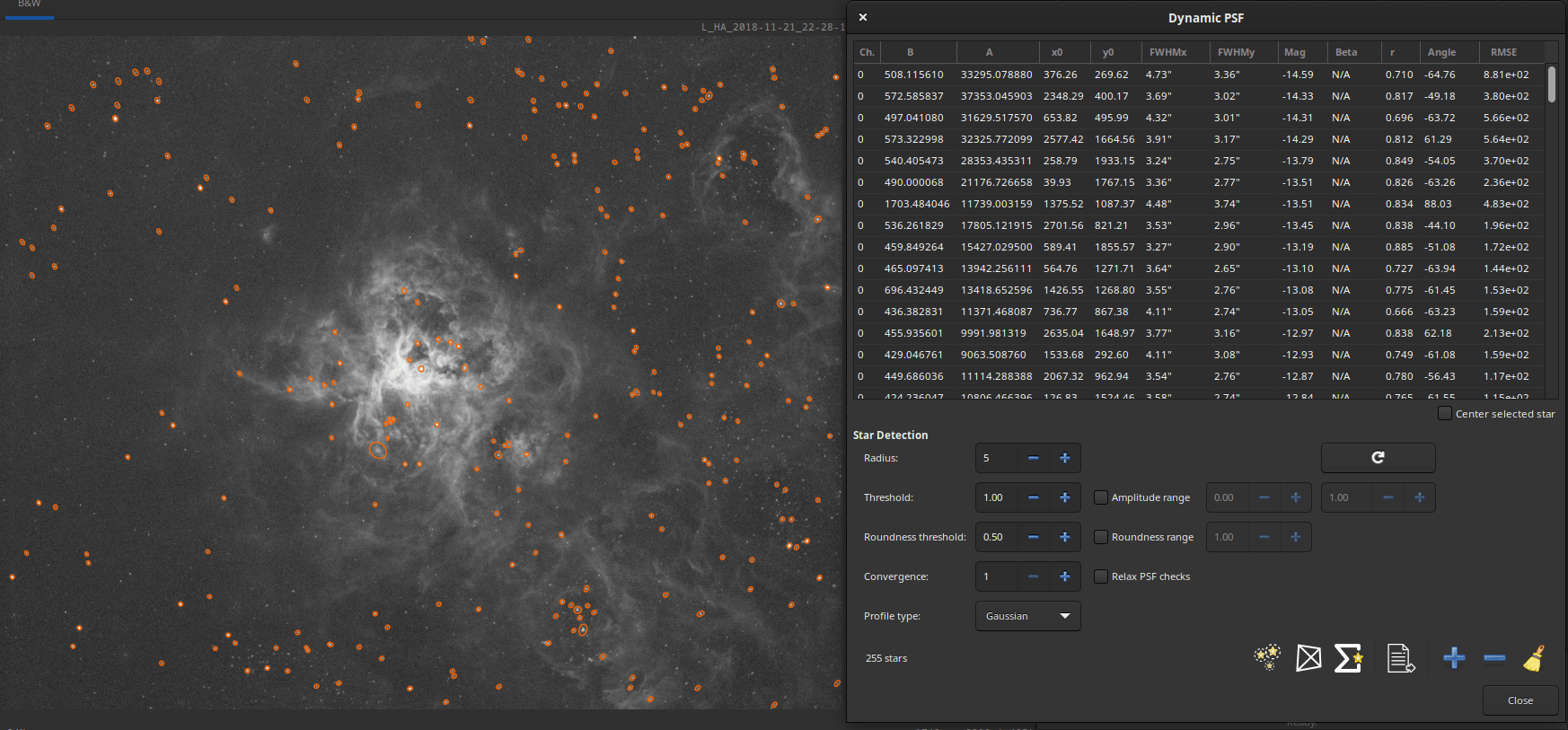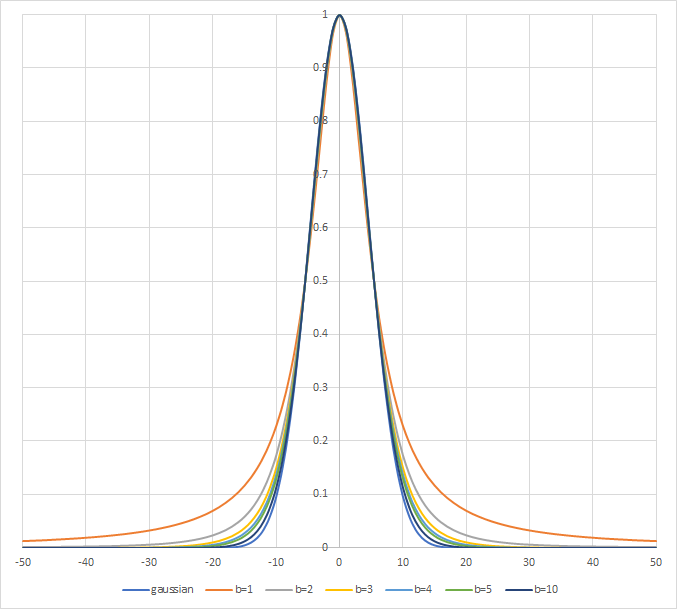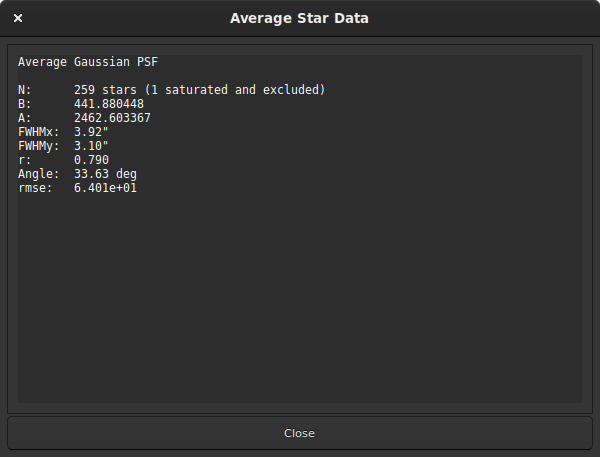Dynamic PSF
This section describes the two essential steps which are undertaken to detect stars in individual frames. The detection on a single image can be run or fine-tuned using or with shortcut Ctrl + F6.

Dynamic PSF running on a deep sky image.
The process is as follows:
make an initial detection of potential star candidates
fit a PSF model on each candidate. Run sanity checks based on model fitting parameters to make sure this is a star and reject non-star candidates.
At the end of this process, the result is a list of stars, with positions in the image wrt. top left corner and measured quantities of all the stars in the list.
Initial star candidates
While it may seem obvious when looking at an image where the stars are, it is a bit more difficult to translate the process into mathemical operations and criteria. This section briefly describes the underlying algorithm. It is inspired from DAOPHOT software manual [Stetson1987], with simplifications brought to boost performance. The original algorithm was aiming at being extensive in detecting all possible stars, serving the purpose of building star catalogues, while Siril needs to detect stars primarily as features for registration . It also needs to be resilient to the wide variety of images that are submitted - most of us do not have a professional-grade astronomical gear in the backyard - and we have had to make some choices regarding prior knowledge of the imaging condition (sampling, seeing etc).
Over the years, our implementation has evolved to produce what it is today. It aims at not missing very bright stars, which are important for registration, and reject as much as possible outliers, while remaining reasonnably fast at doing so.
It can be decomposed in the following steps:
compute the statistics of the image to capture both the background level, as the median of the image, and its noise. This assumes that the image is relatively flat. As a consequence, detection will tend to be less efficient in the corners if heavy vignetting is present after Calibration.
Compute as well a dynamic range, defined as the maximum of the image minus its background. This will later on be useful to detect saturated stars.
smoothen the image with a gaussian kernel. Ideal smoothing would be to use the kernel that has the same FWHM as the image. Instead, we have chosen an arbitrary size which produced satisfactory results over a very wide range of conditions. This enables to be "blind" to the imaging parameters.
on the smoothened version of the image, detect local maxima over a level defined as the background level plus X times the noise (X can be varied using the
thresholdvalue in the GUI). Make sure this is a maximum over a certain box size (defined by theradiusparameter).run sanity check to make sure the maximum and its neighbors are well above the surrounding pixels (to reject patches in the bright parts of nebula for instance).
run sanity check to guess if the core around the maxima is saturated, i.e. consistently close to the upper bound of the dynamic range. If true, run an edge-walking algorithm to detect the limit of the saturated part.
Use first and second derivatives along an horizontal and vertical line passing through the center to guess star local background, amplitude and width in all directions (top, down, left and right).
If the parameters are symmetrical enough in all directions (up to the
roundnessparameter), confirm the star as a potential candidate.
Once the list of potential candidates has been assembled, they are sorted by decreasing amplitudes and fed to the PSF fitting algorithm described in the minimization section.
Models
Two models are used in the Dynamic PSF window. In general, Moffat is much better suited to fit objects such as stars.
An elliptical Gaussian fitting function defined as
(1)\[ G(x,y) = B+Ae^{-\left(\frac{(x-x_0)^2}{2\sigma^2_x}+\frac{(y-y_0)^2}{2\sigma^2_y}\right)}.\]An elliptical Moffat PSF fitting function defined as
(2)\[ M(x,y) = B+A\left(1+\frac{(x-x_0)^2}{\sigma^2_x}+\frac{(y-y_0)^2}{\sigma^2_y}\right)^{-\beta},\]
where:
\(B\) is the average local background.
\(A\) is the amplitude, which is the maximum value of the fitted PSF.
\(x_0\), \(y_0\) are the centroid coordinates in pixel units.
\(\sigma_x\), \(\sigma_y\) are the standard deviation of the Gaussian distribution on the horizontal and vertical axes, measured in pixels.
\(\beta\) is the exponent from the Moffat formula that controls the overall shape of the fitting function. The upper bound of this parameters was set to 10. A higher value is meaningless and means that the Gaussian is good enough to fit the star.
Other parameters are derived from these fitted variables:
\(\text{FWHM}_x\) and \(\text{FWHM}_y\): The Full Width Half Maximum on the X and Y axis in pixel units. These parameters are calculated as follow:
\(\text{FWHM}_x = 2\sigma_x\sqrt{2\log 2}\).
\(\text{FWHM}_y = 2\sigma_y\sqrt{2\log 2}\).
It is possible to obtain the FWHM parameters in arcseconds units. This requires you fill all fields corresponding to your camera and lens/telescope focal in the setting parameter window in the burger menu, then Image Information and Information. If standard FITS keywords
FOCALLEN,XPIXSZ,YPIXSZ,XBINNINGandYBINNINGare read in the FITS HDU, the PSF will also compute the image scale in arcseconds per pixel.
\(r\): The roundness parameter. It is expressed as \(\text{FWHM}_x/\text{FWHM}_y\), with \(\text{FWHM}_x > \text{FWHM}_y\) the symmetry condition.
Another parameters is also fitted in both Gaussian and Moffat models. This is the rotation angle \(\theta\), defined in the range \([-90°,+90°]\). The addition of this parameter implies a coordinate change where the \(x\) and \(y\) variables expressed in (1) and (2) are replaced by \(x'\) and \(y'\):
(3)\[\begin{split} x' &= +x \cos\theta+y \sin\theta \\ y' &= -x \sin\theta+y \cos\theta.\end{split}\]
Displays of two circular PSFs according to a Gaussian profile and a Moffat profile. Both models use the same parameters and the Moffat profile uses uses \(\beta = 1.4\).
Rotated Gaussian and Moffat function have \(\sigma_x=2\sigma_y\), \(\theta=45°\). For Moffat, \(\beta = 1.4\).

Star Profile with Gaussian and Moffat models. Several \(\beta\) values are tried. \(\beta = 10\) gives a profile very close to the Gaussian one.
Minimization
Minimization is performed with a non-linear Levenberg-Marquardt algorithm thanks to the very robust GNU Scientific Library. This algorithm is used to find the minimum of a function that maps a set of parameters to a set of observed values. It is a combination of two optimization techniques: the gradient descent method and the inverse-Hessian method.
The Levenberg-Marquardt algorithm adjusts the trade-off between these two methods based on the curvature of the function being minimized. When the curvature is small, the algorithm uses the gradient descent method, and when the curvature is large, the algorithm uses the inverse-Hessian method.
Since version 1.2.0, the saturated part of the star is removed from the fitting process, enabling to capture much more accurately the non-saturated part. This is what enables to "reconstruct" the star profile when using the Desaturate menu option or unclipstars command.
Use
Dynamic PSF can be called from two different ways depending on what you want:
You may want to fit just one or a few stars. In this case, after drawing a selection around an unsaturated star (this is important for the accuracy of the result) you can either right click and choose the Pick A Star item, click the + button in the Dynamic PSF dialog, or type Ctrl + Space. An ellipse is then drawn around the star. To open the dialog it is also possible to use the shortcut Ctrl + F6.
You may want to analyze as many stars as possible by clicking on the icon
, or using the command line findstar. All detected stars are
surrounded by an ellipse: orange if the star is ok, magenta if the star is
saturated. It is also possible to show the average of the computed parameters
as illustrated below, by clicking on the
button.

Average of the fitted stars in the Gaussian model.
Star detection has a number of uses:
Siril uses it internally for astrometric purposes when registering sequences of images. This is automatic and requires no user intervention.
Because stars are so bright compared with dim features of interest such as nebulae or galaxies, it is very common that some stars in an image will be saturated, meaning their brightness profile is clipped. This can cause problems for some image processing functions, particularly deconvolution, and results in loss of colour information and slightly greater star bloat when applying stretches. Analysis of all the stars will show you which ones are saturated, and you can then use the Desaturate menu option or unclipstars command to fix the problem by synthesis of the clipped part of the profile.
Siril command line
unclipstars
Re-profiles clipped stars of the loaded image to desaturate them, scaling the output so that all pixel values are <= 1.0Ideally all stars in an image should be perfectly round, however problems such as coma, astigmatism and bad tracking, as well as issues such as incorrect back focus to field flatteners, can give rise to patterns of elliptical stars in an image. The ellipses produced by the Dynamic PSF tool can give a good visual illustration of such problems.
Examination of the average star parameters, especially FWHM and the Moffat fitting function beta parameter, can provide information about the quality of seeing in an image.
Detection of all stars is the first step in using the . This synthesizes corrected luminosity profiles for all detected stars, and can be used to create a synthetic star mask which can then be mixed with a starless image generated by Starnet++ to fix otherwise irredeemable stars in an image. In this case detection of stars using the Moffat profile may give a more realistic result and can also make it easier to filter out galaxies incorrectly detected as stars by using the Minimum beta setting.
The Center Selected Star toggle button can be used to find a particular star in the list quickly and easily in the image, by centring it in the viewport. This is useful if you have detected all stars and wish to check specific solutions to ensure they really are a star and not a galaxy or a cosmic ray.
Similarly to this, clicking on an orange or magenta star ellipse in the main viewport will highlight the selected star solution in the Dynamic PSF dialog. This could be useful if you wish to see the parameters of an individual star.
Siril's deconvolution functions support using Dynamic PSF measurements to synthesize a deconvolution function that matches star parameters measured directly from the image.
Configuration
Dynamic PSF can be configured using the settings in the Dynamic PSF dialog:
Radius sets the half-size of the search box. If you have trouble detecting particular stars you can try changing this but usually the default is fine.
Threshold changes the threshold above the noise for star detection. If you increase this value, fewer faint stars will be detected. You may still wish to do this for very noisy images though. Decreasing this value may detect more faint stars, but will also make the algorithm more likely to misidentify random noise spikes as stars.
Roundness threshold sets the allowable ellipticity for detections to be accepted as stars. Highly elliptical stars may occur due to imperfect tracking or aberrations, but sometimes stars that are too close from each others are also detected as a single very elongated star. To highlight all these problems, it is possible to enable a higher bound for the roundness. A maximum value of 1 is equivalent to disabling the range, leaving only the minimum value. This roundness range should be disabled for registration or astrometry.
Convergence sets a criterion used by the solver. Increasing it will allow the solver more interations to converge and can potentially detect additional stars, but may increase the solver running time.
Profile type chooses between solving Gaussian or Moffat profiles for the stars.
Minimum beta sets a minimum permissible value of beta for a detection to be accepted as a star. Galaxies may sometimes be detected as Moffat profile stars but they have diffuse profiles and the value of beta is usually very low, less than around 1.5.
Relax PSF checks allows for relaxation of several of the star candidate quality checks. This is likely to result in a significant increase in false positive star detections, often with wild parameters.
A range of minimum and maximum amplitude can be set to limit the amplitude (parameter named
Ain reports) of detected stars. This is useful if only non-saturated stars need to be selected, for PSF fitting in deconvolution for example. Note that removing the saturated stars from detection can break registration and astrometry.
Tip
The settings defined in this window can be tested on the currently loaded image. However, you have to keep in mind that they will also be used for all images of the sequence, especially for the global alignment registration.
The findstar command will obey the same settings entered in the Dynamic PSF dialog, but it can also be configured using the setfindstar command.
Siril command line
findstar [-out=] [-layer=] [-maxstars=]
Siril command line
setfindstar [reset] [-radius=] [-sigma=] [-roundness=] [-focal=] [-pixelsize=] [-convergence=] [ [-gaussian] | [-moffat] ] [-minbeta=] [-relax=on|off] [-minA=] [-maxA=] [-maxR=]
References
Stetson, P. B. (1987). DAOPHOT: A computer program for crowded-field stellar photometry. Publications of the Astronomical Society of the Pacific, 99(613), 191.